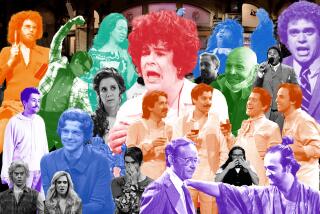Critic’s Notebook: Who will follow Eli Broad as L.A.’s architectural patron?
The influence that Eli Broad has had on the built landscape of Los Angeles over the last two decades has been wide-ranging, as I pointed out in a piece on Sunday exploring his legacy as an architectural patron.
Yet Broad, 77, has hinted that the museum he hopes to build on Bunker Hill may be among his final major civic projects.
FOR THE RECORD:
Architecture patrons: An article in Tuesday’s Calendar section about potential successors to Eli Broad as Los Angeles architectural patrons said one potential candidate, L.A. County Museum of Art Director Michael Govan, had been with the museum since 2004. He arrived in 2006. —
If Broad does begin to move away from the public stage, who might step in to take his place, or to fashion a new kind of architectural patronage in Los Angeles? After canvassing architects, politicians, foundation leaders and others, I’ve come up with a number of contenders.
None of these figures, on his or her own, promises to stand astride the cultural life of Los Angeles the way Broad has. Yet their backgrounds, tastes and priorities offer clues about the roles they might play and the kinds of projects and architecture they might support. And they have time on their side: Three of the people listed are younger than 50, with two still in their 30s.
One of the rare cultural figures in Los Angeles with philanthropic power to go with a strong interest in the design of the public realm is Wallis Annenberg, chairman and president of the Annenberg Foundation. After the deaths of her father, Walter Annenberg, and her stepmother, Lee Annenberg, she moved the foundation’s headquarters from Pennsylvania to Los Angeles and made clear that Southern California will increasingly be a focus of its efforts.
Annenberg was the driving force behind the new Annenberg Community Beach House in Santa Monica, which transformed the former estate of William Randolph Hearst and Marion Davies into a public beach club with smart, kitsch-free architecture by Frederick Fisher and Partners. Architect Zoltan Pali, meanwhile, is remaking the old Beverly Hills Post Office into the Wallis Annenberg Center for the Performing Arts.
Architects who’ve worked with Annenberg, who is 70, say her passion is not so much architecture itself as finding ways to use contemporary design to improve public access to cultural and recreational space — a crucial priority in Los Angeles, with its long-neglected civic realm. They also call her the anti-Broad: a patron who chooses architects carefully but then gives them plenty of freedom to operate.
Another figure with a familiar last name and civic ambition is Casey Wasserman, 36, grandson of the late Hollywood power broker Lew Wasserman. The younger Wasserman, whose day job is running the Wasserman Media Group, is also head of the Wasserman Foundation and a board member at the Los Angeles County Museum of Art and Los Angeles Philharmonic. With Tim Leiweke of AEG, he is making a strong bid to build a new professional football stadium in downtown Los Angeles — a location that makes a good deal more sense in urban and civic terms than the City of Industry, where a rival stadium is planned.
Architects describe Wasserman as one of the few local figures who could the push Leiweke and AEG in the direction of ambitious and meaningful design. Even if the stadium plan fails to pan out, a decade from now he is likely to be playing a significant role in debates about the built environment in Los Angeles.
Few figures in a position of cultural influence in this town, meanwhile, can match Michael Govan when it comes to finely honed expertise in architecture and design. Director of the Los Angeles County Museum of Art since 2004, Govan arrived in Los Angeles with some serious architectural credibility in tow, having overseen an impressive new campus for the DIA Center for the Arts in Beacon, N.Y.
After helping to shepherd a pair of buildings at LACMA by Renzo Piano, an architect he essentially inherited from Broad, Govan is only now beginning to put a clear stamp of his own on the LACMA campus. But it seems likely his architectural influence will extend far beyond that of a typical museum director.
Govan, 46, correctly senses that when the Wilshire subway line is extended west to Fairfax Avenue, the museum will occupy a more central role in the geographical and psychological landscape of Los Angeles than ever before. With Swiss architect Peter Zumthor, Govan is imagining a bold remake of the eastern side of the museum campus timed to the arrival of the subway roughly a decade from now.
Los Angeles City Council President Eric Garcetti, meanwhile, has an unusually sharp understanding of the ways in which architecture as an art form intersects with politics. Although Garcetti, 39, is hardly showy about his knowledge of planning and architecture, he has a grasp of those issues and a real passion for them. Should he win the race to succeed Mayor Antonio Villaraigosa in 2013, hopes would soar for support of forward-looking planning and urban design from City Hall.
The final and arguably most significant entry on the list is not a person but the city of Los Angeles itself. One of the reasons Broad has played such a muscular and prominent role here, of course, is the weakness of the city’s — and the region’s — public institutions. Villaraigosa, whose election prompted a good deal of optimism about civic design and public transit, has proved a deep disappointment in those areas.
But there is a way to change that dismal equation even if Garcetti never makes it to the mayor’s office, and without costly or major reforms to the political structure in Los Angeles and Southern California. If the city were simply to put an intelligently designed system of design competitions into place for new public buildings and other projects, it could promote more positive changes to the urban landscape than the combined efforts of a dozen new patrons.
christopher.hawthorne@latimes.com
More to Read
The biggest entertainment stories
Get our big stories about Hollywood, film, television, music, arts, culture and more right in your inbox as soon as they publish.
You may occasionally receive promotional content from the Los Angeles Times.











